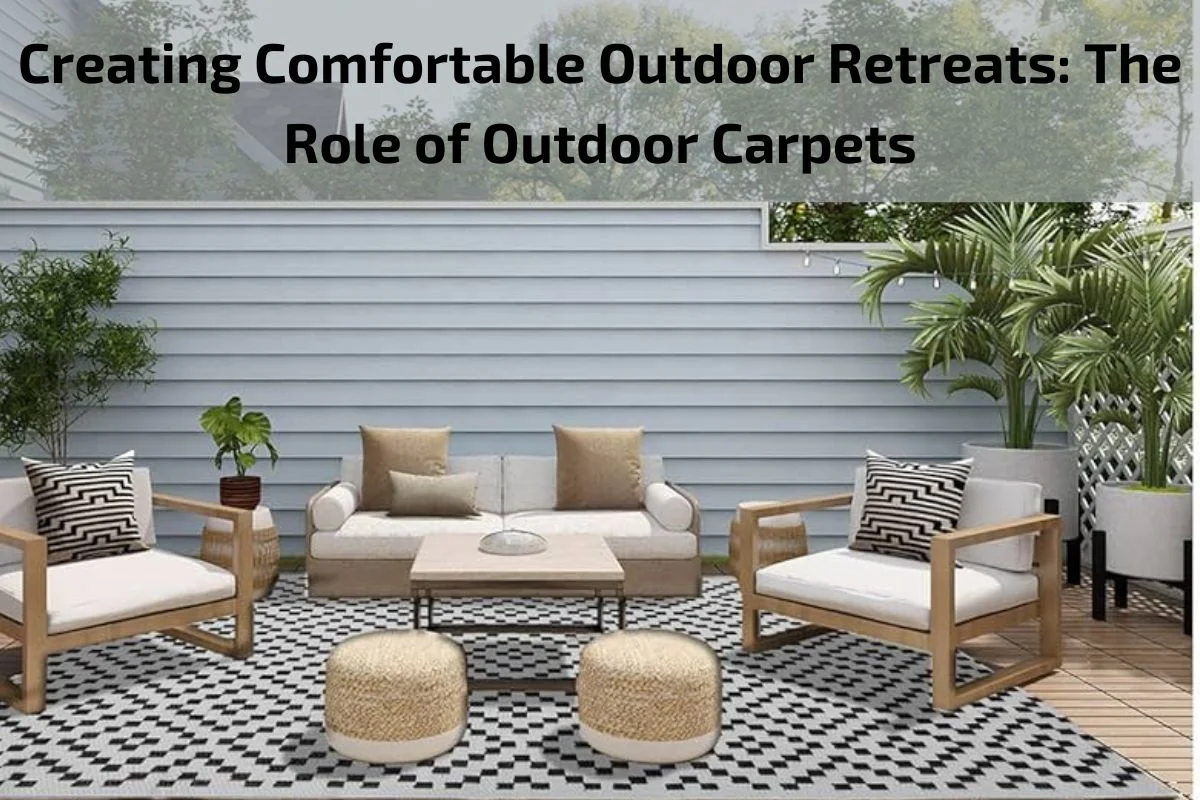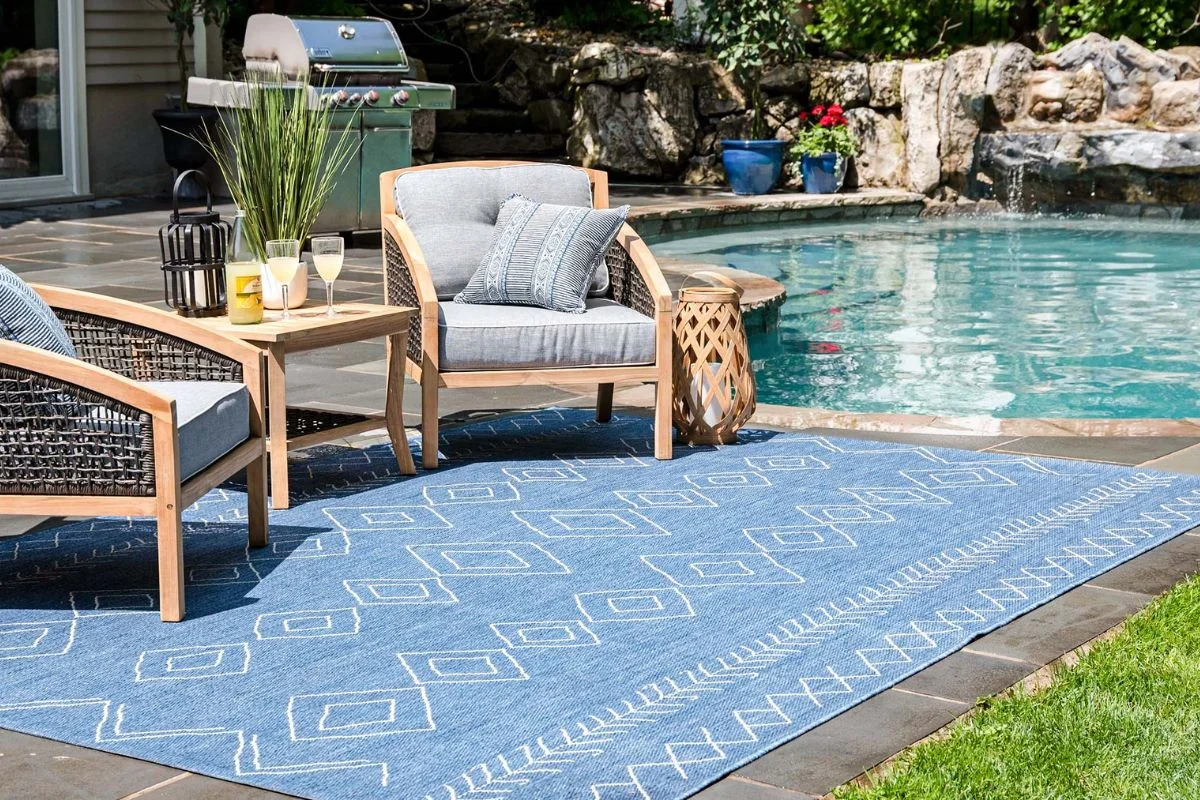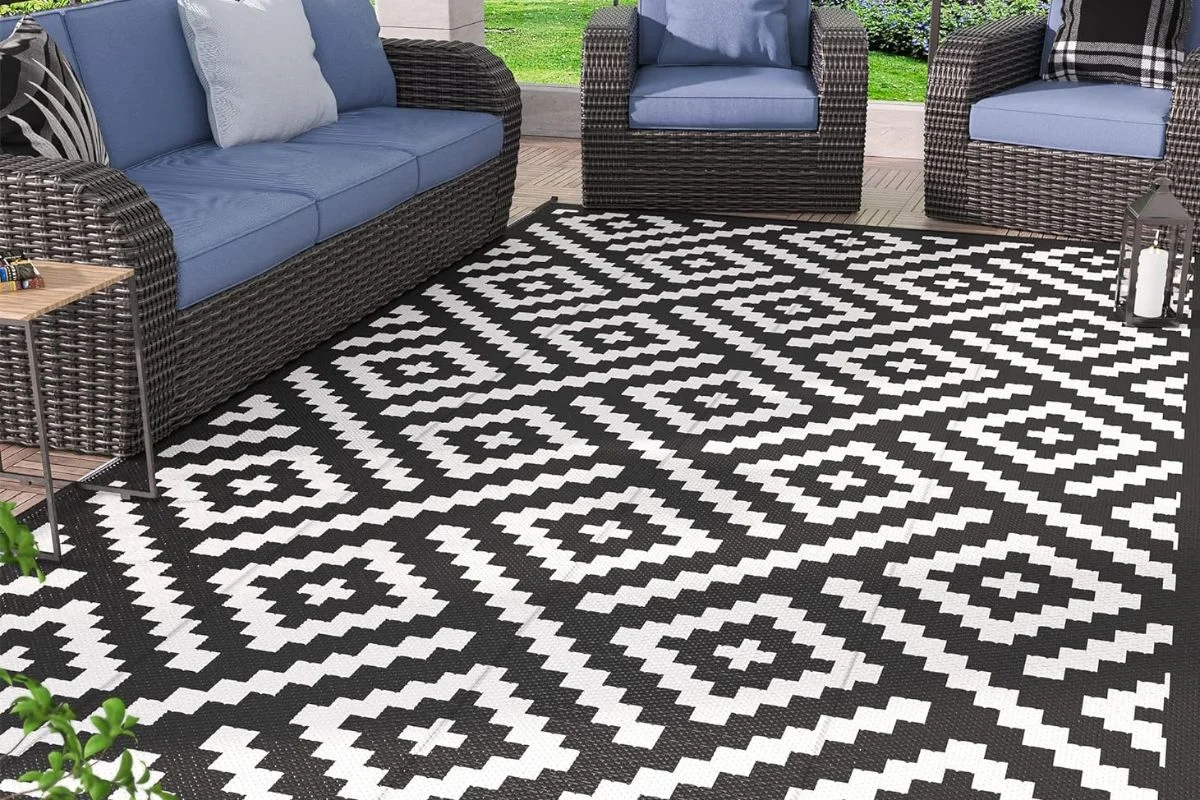In the realm of outdoor living, the quest for comfort and relaxation knows no bounds. From sprawling patios to cozy garden nooks, outdoor spaces are cherished retreats where we seek solace and connection with nature. While furnishings and décor play pivotal roles in shaping the ambiance of these retreats, one often overlooked element can significantly enhance both comfort and style: outdoor carpets.
The concept of outdoor carpets may seem unconventional at first glance, but these versatile floor coverings have swiftly become essential components of outdoor design. They serve a dual purpose, blending functionality with aesthetics to create inviting and comfortable outdoor retreats.
In this exploration, we delve into the role of outdoor carpets in transforming ordinary outdoor spaces into havens of comfort and relaxation. From their ability to soften hard surfaces to their capacity to define seating areas and tie together outdoor décor, outdoor carpets play a crucial role in elevating the overall experience of outdoor living. Join us as we uncover the myriad ways in which outdoor carpets contribute to the creation of comfortable and inviting outdoor retreats, enriching our connection with the great outdoors.
Brief overview of outdoor carpets
Outdoor carpets, also known as outdoor rugs or patio rugs, are specially designed floor coverings intended for use in outdoor spaces such as patios, decks, porches, and poolside areas. Unlike traditional indoor carpets, outdoor carpets are constructed using materials that can withstand exposure to various weather conditions, including sunlight, rain, humidity, and temperature fluctuations. These materials are typically synthetic fibers such as polypropylene, nylon, or polyester, which are resistant to moisture, mold, and fading.
Outdoor carpets come in a wide range of designs, colors, patterns, and sizes to suit different outdoor environments and aesthetic preferences. They can add warmth, comfort, and style to outdoor living spaces, making them more inviting and cozy. Additionally, outdoor carpets can help define specific areas within an outdoor space, such as seating areas or dining areas, creating visual interest and organization.
Maintenance of outdoor carpets is relatively easy, usually requiring regular sweeping or vacuuming to remove dirt and debris. In case of spills or stains, outdoor carpets can be easily cleaned with water and mild detergent. Some outdoor carpets are also treated with UV inhibitors to enhance their resistance to fading caused by prolonged exposure to sunlight.
Importance of Outdoor Carpets in Outdoor Design:
Outdoor carpets play a significant role in outdoor design, offering several important benefits that enhance the functionality, aesthetics, and comfort of outdoor spaces. Here are some key reasons why outdoor carpets are important in outdoor design:
Enhanced Comfort: Outdoor carpets provide a soft and comfortable surface underfoot, making outdoor spaces more inviting and enjoyable for relaxation, socializing, and recreation. They create a cozy atmosphere, encouraging people to spend more time outdoors.
Defined Spaces: Outdoor carpets can help delineate different areas within an outdoor space, such as seating areas, dining areas, and lounging zones. By defining these spaces, outdoor carpets contribute to better organization and functionality, facilitating various outdoor activities and gatherings.
Visual Appeal: Outdoor carpets come in a wide range of colors, patterns, and textures, allowing homeowners to enhance the visual appeal of their outdoor areas. They can complement existing décor, add pops of color, or create visual interest, elevating the overall aesthetics of outdoor design.
Personalization: Outdoor carpets offer an opportunity for personalization and customization in outdoor design. Homeowners can choose carpets that reflect their style preferences and design vision, creating unique outdoor environments that reflect their personality and lifestyle.
Protection of Surfaces: Outdoor carpets provide a protective layer over hard surfaces such as concrete, wood, or stone, helping to prevent damage and wear caused by foot traffic, furniture, and environmental elements. They can extend the lifespan of outdoor flooring materials and reduce maintenance requirements.
Safety: Outdoor carpets can improve safety in outdoor spaces by providing a non-slip surface, especially around pool areas or on wet surfaces. They offer better traction, reducing the risk of slips, trips, and falls, particularly during inclement weather conditions.
Weather Resistance: Designed to withstand exposure to the elements, outdoor carpets are made from durable materials that are resistant to moisture, mold, mildew, and fading caused by sunlight. This weather resistance ensures longevity and performance, even in harsh outdoor environments.
Easy Maintenance: Outdoor carpets are typically easy to clean and maintain, requiring minimal effort to keep them looking fresh and vibrant. Regular sweeping or vacuuming, along with occasional spot cleaning, is usually sufficient to maintain their appearance and functionality.
The Benefits of Outdoor Carpets
Outdoor carpets offer a multitude of benefits that make them a valuable addition to outdoor spaces. Here are some key advantages:
Comfort: Outdoor carpets provide a soft and cushioned surface underfoot, enhancing comfort for walking, sitting, or lounging in outdoor areas. They create a more inviting and cozy environment, encouraging people to spend time outdoors.
Safety: Many outdoor carpets are designed with non-slip backing or materials, which improves traction and reduces the risk of slips and falls, especially in wet or slippery conditions. This feature enhances safety, particularly around pool areas or on decks.
Aesthetic Appeal: With a wide range of colors, patterns, and textures available, outdoor carpets can add visual interest and style to outdoor spaces. They allow homeowners to personalize their outdoor design, complement existing décor, or create focal points in the landscape.
Defined Spaces: Outdoor carpets can help define different areas within an outdoor space, such as seating areas, dining zones, or play areas. By delineating these spaces, outdoor carpets contribute to better organization and functionality, making outdoor living more enjoyable and efficient.
Protection: Outdoor carpets provide a protective layer over hard surfaces like concrete, wood, or stone, shielding them from damage caused by foot traffic, furniture, or environmental elements. This protection can extend the lifespan of outdoor flooring materials and reduce maintenance costs.
Weather Resistance: Made from durable materials such as polypropylene or polyester, outdoor carpets are designed to withstand exposure to various weather conditions, including sunlight, rain, and humidity. They resist fading, mold, and mildew, ensuring longevity and performance in outdoor environments.
Easy Maintenance: Outdoor carpets are relatively easy to clean and maintain. Regular sweeping or vacuuming removes dirt and debris, while occasional spot cleaning with water and mild detergent can address spills or stains. This low-maintenance feature makes outdoor carpets a practical choice for busy homeowners.
Versatility: Outdoor carpets can be used in a variety of outdoor settings, including patios, decks, porches, balconies, or poolside areas. They can also be rolled up and stored during colder months or inclement weather, providing flexibility in outdoor design.
Types of Outdoor Carpets
There are several types of outdoor carpets available, each with its own unique characteristics and suitability for different outdoor environments. Here are some common types:
Synthetic Fiber Carpets: Synthetic fiber carpets are the most popular choice for outdoor use due to their durability and weather resistance. Materials such as polypropylene, nylon, and polyester are commonly used because they are resistant to moisture, mold, and fading. These carpets come in various colors, patterns, and textures to suit different design preferences.
Grass-like Carpets: Grass-like outdoor carpets mimic the appearance and texture of natural grass, providing a realistic and natural aesthetic for outdoor spaces. These carpets are often made from synthetic materials like polyethylene or polypropylene, offering the look of grass without the maintenance requirements of real grass, such as mowing or watering.
Sisal or Jute Carpets: Sisal or jute carpets are made from natural fibers derived from the sisal plant or the jute plant. While these carpets may not be as weather-resistant as synthetic options, they add a rustic and organic touch to outdoor areas. Sisal and jute carpets are best suited for covered outdoor spaces where they are protected from direct exposure to rain and sunlight.
Berber Carpets: Berber carpets are characterized by their looped construction, which creates a textured surface that is durable and resistant to wear. These carpets are often made from synthetic fibers like olefin or nylon and are suitable for high-traffic outdoor areas such as patios or decks.
Recycled Carpets: Recycled outdoor carpets are made from recycled materials such as plastic bottles or rubber tires. These eco-friendly options offer durability and weather resistance while reducing environmental impact. Recycled carpets come in various styles and colors, making them a sustainable choice for outdoor design.
Modular Carpets: Modular outdoor carpets consist of individual tiles or squares that can be assembled to cover large or irregularly shaped outdoor areas. These carpets offer versatility and ease of installation, allowing homeowners to create custom patterns or replace damaged tiles as needed. Modular carpets are typically made from synthetic materials and are suitable for a wide range of outdoor applications.
Marine Carpets: Marine-grade carpets are designed specifically for use in marine environments such as boats, docks, or marinas. These carpets are highly durable, UV resistant, and resistant to mold and mildew. Marine carpets are typically made from synthetic fibers like polypropylene or polyester and feature a low-pile design for easy cleaning and maintenance.
Design Tips for Using Outdoor Carpets
When incorporating outdoor carpets into your outdoor design, there are several design tips to keep in mind to achieve a cohesive and visually appealing look. Here are some suggestions:
Consider the Size and Shape: Before purchasing an outdoor carpet, carefully measure the size and shape of your outdoor space to determine the appropriate dimensions for the carpet. Ensure that the carpet fits comfortably within the designated area without overwhelming or crowding the space.
Define Zones: Use outdoor carpets to define different zones within your outdoor space, such as seating areas, dining areas, or lounging areas. Choose carpets of varying sizes, shapes, or colors to delineate these zones and create visual interest.
Coordinate with Furniture: Coordinate the color, pattern, or texture of your outdoor carpet with the furniture and accessories in your outdoor space. Choose complementary or matching colors to create a cohesive and harmonious look that ties the entire outdoor design together.
Mix and Match: Don’t be afraid to mix and match different styles or types of outdoor carpets to add texture and dimension to your outdoor design. Experiment with layering carpets of varying sizes or shapes to create visual depth and complexity.
Consider Traffic Patterns: Take into account the traffic patterns and flow of movement in your outdoor space when positioning outdoor carpets. Place carpets strategically in areas where people are likely to walk or gather, while leaving open spaces for easy access and movement.
Create Focal Points: Use outdoor carpets to create focal points or visual accents in your outdoor design. Choose carpets with bold patterns, vibrant colors, or unique textures to draw attention and add visual excitement to specific areas of your outdoor space.
Match to Landscape: Consider the surrounding landscape and architectural elements when selecting outdoor carpets. Choose carpets that complement the natural surroundings, such as earthy tones for rustic landscapes or vibrant colors for modern settings.
Layer with Rugs: Experiment with layering outdoor carpets with rugs or mats to add interest and dimension to your outdoor design. Layering can create visual contrast, soften hard surfaces, and enhance the overall aesthetic appeal of your outdoor space.
Consider Maintenance: Choose outdoor carpets that are easy to clean and maintain to ensure long-lasting beauty and functionality. Opt for materials that are resistant to moisture, mold, and fading, and follow manufacturer’s guidelines for proper care and maintenance.
Personalize Your Space: Lastly, use outdoor carpets as an opportunity to infuse your personality and style into your outdoor design. Whether you prefer bold patterns, subtle textures, or playful colors, choose carpets that reflect your unique taste and preferences to create a space that feels distinctly yours.
Maintainers Tip for Outdoor Carpets
Maintaining outdoor carpets is essential to preserve their appearance, durability, and longevity. Here are some maintenance tips to keep your outdoor carpets looking fresh and vibrant:
Regular Cleaning: Sweep or vacuum your outdoor carpet regularly to remove dirt, debris, leaves, and other particles. This prevents buildup and helps maintain the carpet’s appearance.
Spot Cleaning: Address spills or stains promptly to prevent them from setting into the fibers of the carpet. Blot the affected area with a clean cloth or sponge dampened with water and mild detergent. Avoid harsh chemicals or bleach, as they may damage the carpet fibers.
Deep Cleaning: Periodically deep clean your outdoor carpet to remove embedded dirt, stains, and odors. You can use a carpet cleaner specifically formulated for outdoor carpets or rent a carpet cleaning machine for more thorough cleaning.
Hose Down: Use a garden hose to rinse off your outdoor carpet periodically, especially if it accumulates dust, pollen, or other outdoor debris. Hang the carpet to dry completely before placing it back in its outdoor location.
Sun Protection: If possible, avoid prolonged exposure of your outdoor carpet to direct sunlight, as UV rays can cause fading and deterioration of the fibers over time. Consider placing your outdoor carpet in shaded areas or using a canopy or umbrella for protection.
Prevent Mold and Mildew: Outdoor carpets are susceptible to mold and mildew growth, especially in humid or damp conditions. To prevent this, ensure proper drainage underneath the carpet and allow it to dry thoroughly after rain or cleaning.
Rotate and Realign: Periodically rotate or realign your outdoor carpet to promote even wear and prevent certain areas from becoming worn or faded more quickly than others.
Storage: If you live in an area with harsh winters or extended periods of inclement weather, consider storing your outdoor carpet indoors during the offseason to protect it from damage. Make sure the carpet is clean and completely dry before storing it to prevent mold or mildew growth.
Trim Vegetation: Trim back any vegetation or foliage around your outdoor carpet to prevent it from becoming trapped underneath or causing damage to the fibers.
Follow Manufacturer’s Instructions: Always follow the manufacturer’s guidelines and recommendations for cleaning and maintenance specific to your outdoor carpet to ensure optimal performance and longevity.
Conclusion
In conclusion, outdoor carpets offer a multitude of benefits for enhancing outdoor spaces, providing comfort, safety, aesthetic appeal, and functionality. With a variety of types, designs, and maintenance tips available, homeowners can effectively incorporate outdoor carpets into their outdoor design to create inviting and stylish environments





